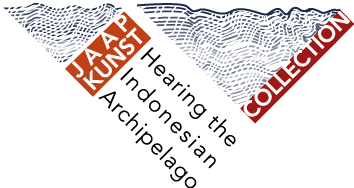The Collectors
Wax cylinder recording in Papua, Indonesia. Photo by Jaap Kunst
Jaap Kunst
Trained as a lawyer in the Netherlands, Jaap Kunst (1891-1960) lived and worked in the Dutch East Indies between 1919 and 1934 as a colonial administrative officer. He worked in the office from 7am to 2pm and devoted all his spare time, including late evenings and early mornings, to his research of music of the Indonesian archipelago that he regarded to be at the brink of extinction. In 1930 and 1931 he occupied the unique post of government musicologist (Gouvernementsmusicoloog), a job he had lobbied into existence with the help of historian Johan Huizinga. His many letters speak of his urge, obsession almost, to capture, collect and safeguard as much music as he could, before it would stop being practiced. To a large extent he and his wife Katy Kunst-Van Wely paid their research – recording equipment, expeditions, musical instruments, archiving tools – from their own private means.
Kunst owes his worldwide reputation as a founding father of ethnomusicology to his mid-twentieth- century conceptualization of this discipline that was adopted in virtually the whole Anglophone academic world.
Early fieldworkers such as Kunst directly engaged with those who made and enjoyed the music that, in European ears and eyes, was exotic at best, but mostly “weird” and “primitive”. This direct engagement was instigated and enhanced by nascent technologies of sound recording, the ability to capture sound, replay it, get used to it, transcribe it and discover that there are levels of complexity and intricacy in it that complicate qualifications such as “primitive” or weird. Kunst asserted that music from outside Europe should be studied and judged on the basis of the aesthetic, technical and formal starting points of those participating in the community or “ethnos” in which it was created and enjoyed, and not on the basis on European aesthetic premises. His emphasis on cultural diversity was ground-breaking in the context of comparative musicology, not in the least because it encompassed an inherent acknowledgement of the fact that music is a set of activities rather than an object, not only shaped by those who create it, but also by those who appreciate, criticize or interpret it in a specific sociocultural environment.
Jaap Kunst teaching. Wikimedia Photo
Katy Kunst-Van Wely
The eldest daughter of a Dutch-Indies government official, Katy van Wely (1897-1992) was born in Malang (East Java) and trained as a French teacher, prior to her marriage with Jaap Kunst. Their honeymoon to Bali after their marriage in 1921 was in fact a research expedition. The couple spent most of their free time as well as their available money to recording and collecting music and musical instruments from the Archipelago. They published a number of articles jointly. Decisions about the organization and curation of their Musicological Archive (Musicologisch Archief) – what material was to be admitted and what wasn’t, how the material was to be organized and numbered, how it was to be annotated and described – may have been taken by Katy Kunst-Van Wely as much as by her husband. Jaap Kunst himself suggested this in his correspondence to peers, claiming that Mrs. Kunst’s involvement in the Archive was absolutely indispensable. Katy Kunst made her own recordings in West Java (Sunda) in 1931, where she also recorded musicians hailing from North Sumatra.
Katy Kunst-Van Wely. Photo by Jaap Kunst
Pastor Pieter Middelkoop
Dutch assistant pastor who lived as a missionary in Central Timor (Kapan) from the 1920s to the 1950s. He made recordings for Jaap Kunst (files 323-327).
Father Jan Verschueren
Dutch Catholic missionary in Northern New Guinea from 1931 until 1970, where he lived with the Marind Anim people. He made recordings of local music, on request of Jaap Kunst (308-311 and 317-321).
Missionaries, including Pieter Middelkoop (front right) in the 1930s, presumably on Timor
